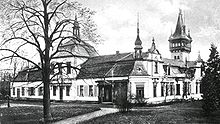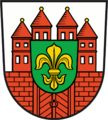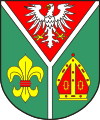Plotho
Plotho is the name of an old, highly free noble family from the Archdiocese of Magdeburg . The ancestral seat of the Lords of Plotho was the Plothe moated castle in Altenplathow , today a district of Genthin . Branches of the family still exist today.
history
origin
The family is probably of Wendish descent and was a long-established Slavic gentleman. It appears for the first time in 1135 with Hermannus de Plothe as a witness in a document from Archbishop Conrad of Magdeburg . In 1170 Johann Plotho appears in a document as a witness. 1171 a Johannes, Herr zu Plothe, with the title Edler Herr von Plotho is named in a privilege of the royal office Altenplathow.


In 1237 the brothers Johann and Gebhard von Plothe granted the town of Kyritz the Stendal town charter . In 1245, Johannes dei gratia dominus de Plothe and his relatives granted the dressmaker's guild in Kyritz a privilege. They also had a mint in Kyritz . With the death of lord Wolf von Plotho in 1294, the castle and the rule , Altenplathow, Genthin and numerous other villages, fell to the Archdiocese of Magdeburg. The Lords of Plotho became ministerials to the Magdeburg archbishops and held high offices in their territories. However, feudal relationships with the Margraves of Brandenburg also existed early on . The reliable line of tribe does not begin until 1378 with the noble Gebhard von Plotho on Parey, Jerichow and Plote.
Possessions



The property could be expanded considerably over time. In the Archdiocese of Magdeburg, the Lords of Plotho owned, among others, the palace and rule of Parey , Lüttgenziatz (today a district of Möckern ), Genthin, Zorien , Ringfurth and Ihleburg . At the end of the 15th century, Gerbstedt with the monastery in the county of Mansfeld and in the 16th century the castle Weißandt-Gölzau in the Principality of Anhalt came into family ownership.
In Flanders , members of the family were able to acquire the Engelmünster (Ingelmunster), Vive and Rosebeck lordships in the 16th century. During the 19th century, various branches were also owned in East Prussia , Silesia and in the Bavarian Vogtland .
The male Flanders line of the family died out with the death of Charles Louis Marie Ghislain Baron de Plotho et d ' Ingelmunster ( West Flanders ) in 1825 and his brother Ferdinand Maximilien Auguste Ghislain († January 19, 1835). The former had already bequeathed his property to Charles Albéric Clement Descantons de Montblanc together with his sister Suzanne Agathe Félicité. The younger, also childless, bequeathed his property to Montblanc, which was not ennobled until June 30, 1841 by Louis-Philippe I of France. On July 20, Leopold I , King of the Belgians , was raised to the rank of count .
The Prussian branch challenged these legacies. The Prussian barons took over the property there. Montblanc litigated in Magdeburg, Halberstadt and before the Prussian Higher Tribunal through three instances and lost. In return, the Prussians litigated Ingelmunster. They lost in Belgian courts so that Charles Descantons de Montblanc could then take over the Belgian possessions from his father.
Lines and status surveys
Otto, Gebhard and Johann, Gebhard's three sons, noble lord of Plotho on Jerichow , founded three lines in the middle of the 15th century. From Otto's, also Jerichow'schen line, Sebastian came from Plotho, 1540 provost to Merseburg was. Members of this branch also served the French king as colonels of war. The line became extinct in the 16th century. Gebhard was the progenitor of the lines with headquarters in Parey and Grabow . From the Parey line came Ludwig Otto von Plotho, Herr auf among others Parey and Gerbstedt, who died in 1731 as a royal Prussian real secret councilor and president of the court of appeal . His son Erich Christoph von Plotho was the envoy and plenipotentiary minister of Frederick the Great with the dignity of a secret council of state and minister of war . The third Johannische Linie came to Holland. From this branch came Wolfgang Edler von Plotho, who on September 13, 1643 in Vienna by Emperor Ferdinand III. for himself and his descendants was raised to the imperial baron status. He now bore the title “Freiherr von Engelmünster auf Parey and Wilzensandt” , and his old master class was also confirmed in his diploma . Engelmünster was a barony in Flanders that members of this line bought for sale in the 16th century.
Due to membership of the Order of St. John , two members of the family were entered in the nobility registers in the Kingdom of Bavaria in 1814 . On October 15, 1840, Wilhelm Heinrich von Plotho received the title of Chamberlain in the Duchy of Magdeburg , which was attached to the old Plotho man Parey by the highest decree of November 6, 1846. In 1878 the Kingdom of Prussia was recognized as noble lords and barons for all members of the family.
coat of arms
Family coat of arms
The family coat of arms shows a red lily with a gold band in silver . On the helmet the red lily between two carrot bodies leaning outwards , with a silver feather crown and a green dress with a gold collar. The helmet covers are red-silver.
City and municipal coats of arms
The lily from the family coat of arms of the Lords of Plotho still appears today in some district, city and community coats of arms in northern Brandenburg and Saxony-Anhalt .
Coat of arms of Parey , part of the municipality of Elbe-Parey
Coat of arms of the Elbe-Parey community
Coat of arms of the municipality of Kade
Coat of arms of the city of Kyritz
Coat of arms of the Ostprignitz-Ruppin district
Coat of arms of the municipality of Wusterhausen / Dosse
Name bearer
- Carl von Plotho (1780–1820), Prussian lieutenant colonel, military historian and writer
- Carl von Plotho (District Administrator) (1827–1886), Prussian Chamberlain and District Administrator
- Carl Friedrich von Plotho (1796–1874), Prussian chamberlain and district administrator
- Christian von Plotho (1756–1802), Prussian district administrator
- Elisabeth von Plotho (1853–1952), married von Ardenne, was the model for Theodor Fontane's fictional character Effi Briest
- Erich Christoph von Plotho (1707–1788), German politician
- Franz Philipp von Plotho (1657–1714), Prussian major general
- Friedrich Franz Ernst von Plotho (1698–1766), Prussian Colonel, Chief of Garrison Regiment No. 4
- Gebhard von Plotho (1860–1927), Prussian major general
- Ludwig von Plotho (1698–1780), Prussian Privy Councilor and District Administrator
- Ludwig Otto von Plotho (1663–1731), Prussian Higher Appeal Court President and Minister of Justice
- Manfred von Plotho (1908–1987), German officer
- Wilhelm Julius von Plotho (1728–1802), Prussian major general
- Wolfgang von Plotho (Freiherr) (1590–1657), Prussian district administrator of the Jerichow district
- Wolfgang von Plotho (District Administrator) (1849–1926), German manor owner, administrative officer and writer
- Wolfgang von Plotho (Lieutenant General) (1879–1946), German Lieutenant General
literature
- Otto Hupp : Munich calendar 1916. Book a. Art print, Munich / Regensburg 1916.
- Genealogical manual of the nobility , Adelslexikon. Volume X, Volume 119 of the complete series, CA Starke Verlag, Limburg (Lahn) 1999, ISSN 0435-2408
- Erich-Christoph Freiherr von Plotho: knights, canons and colonels - family chronicle of the noble lords and barons of Plotho . CA Starke Verlag, Limburg 2007, ISBN 978-3-7980-0579-2 .
- Plotho, noble gentlemen and barons . In: Ernst Heinrich Kneschke : New general German nobility lexicon . Volume 7, Friedrich Voigt's Buchhandlung, Leipzig 1867, pp. 187–188.
- Plotho, the barons and lords of . In: Leopold von Zedlitz-Neukirch : New Prussian Adels Lexicon . Volume 4, Gebrüder Reichenbach, Leipzig 1837, pp. 40-41.
- Gothaisches genealogical pocket book of the baronial houses. Eighth year, 1858, p. 501ff
Web links
Individual evidence
- ↑ George Adalbert of Mülverstedt : Regesta Archiepiscopatus Magdeburgensis I . Magdeburg 1846, no.425
- ^ M e Surmont: Mémoire pour Mme la Comtesse de Montblanc et ses enfants, intimés, contre Mm. les barons de Plotho, appelants devant la cour d'appel de Gand. Ghent 1865.
- ^ WF Vanden Walle: An Extraordinary Destiny. In: WF Vanden Walle, David de Coonman (Eds.): Japan & Belgium. Four Centuries of Exchange. Brusseles / Aichi 2005, ISBN 2-9600491-0-1 , p. 155, fn. 5
- ^ Genealogical handbook of the nobility. Volume F XXVI, pp. 297/98. CA Starke-Verlag, 2014.
- ^ Genealogy. Manual. Volume XI, p. 297.
- ^ Genealogy. Handbook of the nobility. Volume A XI, p. 279.
- ^ Genealogy. Handbook of the nobility. Volume A XI, p. 305.
- ^ Genealogy. Handbook of the nobility. Volume A XI, p. 296.
- ^ Genealogy. Handbook of the nobility. Volume A XI, p. 306.
- ^ Genealogy. Manual. Volume A XI, p. 307.






